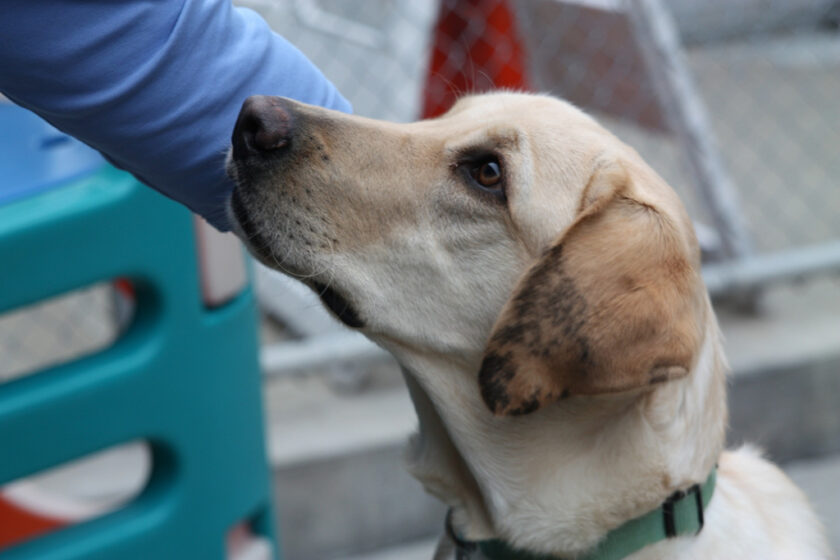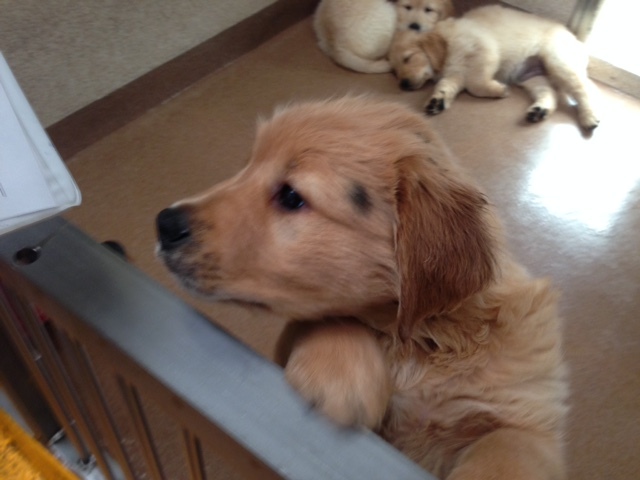One in a Million! Unique Markings in GDB Dogs
Thursday January 18, 2024

We recently shared the story of Neutrino, a handsome long-coated black Lab/Golden cross, and thought you might all be interested to hear about some other slightly unique dogs in our program and how science explains their differences. Get ready for your biology lesson for the day!
Guide Dogs for the Blind’s dog population consists of Labrador Retrievers, Golden Retrievers, and Lab/Golden crosses (both short and long coated) who come in black, yellow (of varying shades), and chocolate. On occasion, these dogs may be born with a little variety in their appearance. GDB regularly includes dogs in our program who have non-significant cosmetic differences. This includes puppies with distinctive color markings as well as puppies born with unique builds such as a short tail, or off-set ears, that would not interfere with their physical ability to perform guidework or become a K9 Buddy.
Today we are going to talk more about “mismarks” which is a word used to describe a marking that is not standard for a dog’s breed in color, size, or location. To understand what causes these unique markings, we’ll cover some genetics basics first.

There are spots on the canine genes called “loci” (or “locus” for a single spot) that deal with different coat colors. There are thousands of these loci, and it gets complicated quickly. Fortunately for us, in Labradors (and Goldens) we only need to focus on two loci to determine whether a dog will be black, chocolate, or yellow: the B and E loci.
Locus B comes in two varieties: black and brown. Black (B) is dominant, brown (b) is recessive, and the color applies not only to the dog’s fur, but to some extent all of the areas of pigment: nose, lips, foot pads, and around the eyes. If the dog in question has even one copy of the dominant (B) gene, they will have a black coat and black nose, etc. Only if the dog has two copies of the recessive gene (b) will their coat and nose look brown or chocolate.
So where do yellow Labradors and Golden Retrievers fit in? For yellow Labs and Golden Retrievers, we need to go to Locus E, which works a little differently. In recessive form (e), it suppresses or prevents the coat color of the B locus from expressing itself. In other words, the black or chocolate color won’t show up in the fur if the dog is carrying e/e. Instead, their coats will be yellow. Recessive (e) doesn’t remove the other areas of pigment, however – they should have black noses, or at least a black rim around their noses if they have B/B or B/b on that first locus. If they have b/b on that first locus, then those other areas of pigment will be liver-colored. Couple that with e/e for recessive yellow coat color and we see a yellow-coated dog with liver b/b pigment. Golden Retrievers are genetically black (BB ee) but appear on a spectrum of golden (yellow) to reddish due to their (ee) genes restricting the development of black pigment.
In a way, the coat colors are like a ladder following a hierarchy. The first rung (or loci) tells you if the dog is black or brown, then the 2nd rung takes that black or brown dog and if double recessive, turns its fur yellow. All in all, there are nine different genotype combinations, or rungs, on the ladder.

So how does all this relate to our dogs with unique markings? Sometimes when an embryo is developing one of its skin cells undergoes a mutation. Any cell that is produced by this irregular cell dividing also contains the mutation. Sometimes a dog will have a mutation in a skin cell in which (ee) becomes (Ee). This allows the black pigment to form in cells descended from that one original irregular cell. This phenomenon is well documented in Labrador Retrievers and Golden Retrievers. These dogs are sometimes referred to as Mosaics. While we’re tempted to call it a birthmark, it’s technically considered an alteration at the cellular level. The cells responsible for reproduction originate from a different place than the skin cells and therefore are not affected by this mutation thus a dog that has a coloring mismark will not produce its dual color in offspring. Phew! As you can see, genetics is a complicated business!
As our clients and puppy raisers know, being with a dog in public often draws attention and they end up answering lots of questions about the dog and GDB’s mission. The staff at GDB take into consideration the interactions a team will have with the public and how a unique-looking dog might affect their work and travel. These decisions are not made lightly and we have an extensive group of individuals here at GDB included in this process.
We hope you enjoyed seeing some of our wonderful GDB dogs with interesting mismarks and learning more about how they came to be!

